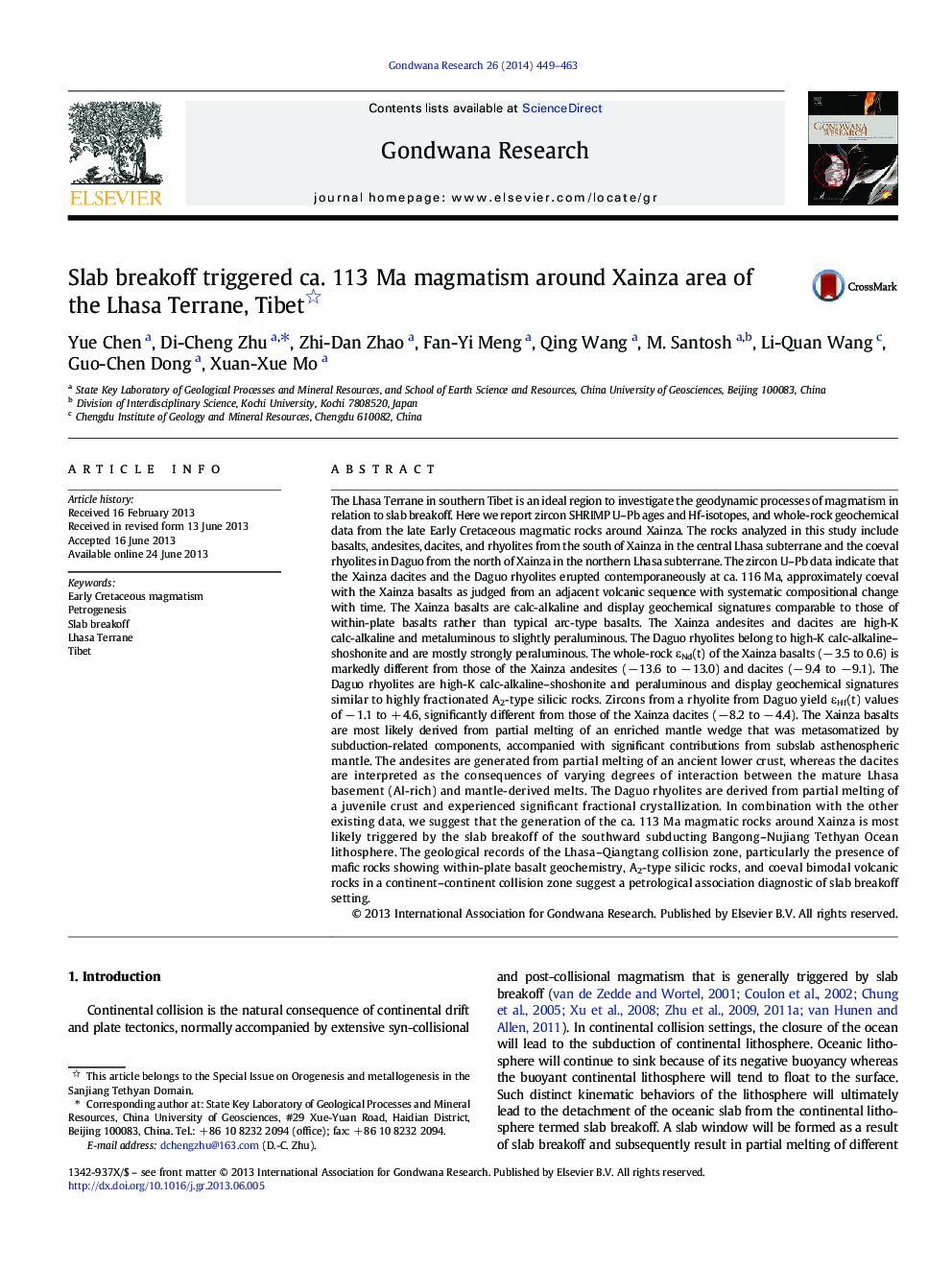| کد مقاله | کد نشریه | سال انتشار | مقاله انگلیسی | نسخه تمام متن |
|---|---|---|---|---|
| 4727281 | 1356368 | 2014 | 15 صفحه PDF | دانلود رایگان |

• Synchronous magmatism of ca. 113 Ma around Xainza, central Tibet
• Within-plate chemical signatures of basalts and coeval A2-type rhyolites
• Subslab asthenosphere- and subarc mantle wedge-derived hybrid basaltic magmas
• Magmatic response to slab breakoff in a continent–continent collision zone
The Lhasa Terrane in southern Tibet is an ideal region to investigate the geodynamic processes of magmatism in relation to slab breakoff. Here we report zircon SHRIMP U–Pb ages and Hf-isotopes, and whole-rock geochemical data from the late Early Cretaceous magmatic rocks around Xainza. The rocks analyzed in this study include basalts, andesites, dacites, and rhyolites from the south of Xainza in the central Lhasa subterrane and the coeval rhyolites in Daguo from the north of Xainza in the northern Lhasa subterrane. The zircon U–Pb data indicate that the Xainza dacites and the Daguo rhyolites erupted contemporaneously at ca. 116 Ma, approximately coeval with the Xainza basalts as judged from an adjacent volcanic sequence with systematic compositional change with time. The Xainza basalts are calc-alkaline and display geochemical signatures comparable to those of within-plate basalts rather than typical arc-type basalts. The Xainza andesites and dacites are high-K calc-alkaline and metaluminous to slightly peraluminous. The Daguo rhyolites belong to high-K calc-alkaline–shoshonite and are mostly strongly peraluminous. The whole-rock εNd(t) of the Xainza basalts (− 3.5 to 0.6) is markedly different from those of the Xainza andesites (− 13.6 to − 13.0) and dacites (− 9.4 to − 9.1). The Daguo rhyolites are high-K calc-alkaline–shoshonite and peraluminous and display geochemical signatures similar to highly fractionated A2-type silicic rocks. Zircons from a rhyolite from Daguo yield εHf(t) values of − 1.1 to + 4.6, significantly different from those of the Xainza dacites (− 8.2 to − 4.4). The Xainza basalts are most likely derived from partial melting of an enriched mantle wedge that was metasomatized by subduction-related components, accompanied with significant contributions from subslab asthenospheric mantle. The andesites are generated from partial melting of an ancient lower crust, whereas the dacites are interpreted as the consequences of varying degrees of interaction between the mature Lhasa basement (Al-rich) and mantle-derived melts. The Daguo rhyolites are derived from partial melting of a juvenile crust and experienced significant fractional crystallization. In combination with the other existing data, we suggest that the generation of the ca. 113 Ma magmatic rocks around Xainza is most likely triggered by the slab breakoff of the southward subducting Bangong–Nujiang Tethyan Ocean lithosphere. The geological records of the Lhasa–Qiangtang collision zone, particularly the presence of mafic rocks showing within-plate basalt geochemistry, A2-type silicic rocks, and coeval bimodal volcanic rocks in a continent–continent collision zone suggest a petrological association diagnostic of slab breakoff setting.
Figure optionsDownload as PowerPoint slide
Journal: Gondwana Research - Volume 26, Issue 2, September 2014, Pages 449–463